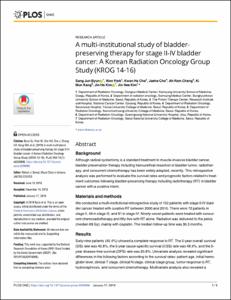KUMEL Repository
1. Journal Papers (연구논문)
1. School of Medicine (의과대학)
Dept. of Radiation Oncology (방사선종양학)
A multi-institutional study of bladderpreserving therapy for stage II-IV bladder cancer: A Korean Radiation Oncology Group Study (KROG 14-16)
- Keimyung Author(s)
- Byun, Sang Jun; Kim, Jin Hee
- Department
- Dept. of Radiation Oncology (방사선종양학)
- Journal Title
- PLoS One
- Issued Date
- 2019
- Volume
- 14
- Issue
- 1
- Abstract
- Background
Although radical cystectomy is a standard treatment in muscle-invasive bladder cancer, bladder preservation therapy including transurethral resection of bladder tumor, radiotherapy, and concurrent chemotherapy has been widely adopted, recently. This retrospective analysis was performed to evaluate the survival rates and prognostic factors related to treatment outcomes following bladder-preserving therapy including radiotherapy (RT) in bladder cancer with a curative intent.
Materials and methods
We conducted a multi-institutional retrospective study of 152 patients with stage II-IV bladder cancer treated with curative RT between 2000 and 2010. There were 72 patients in stage II, 49 in stage III, and 31 in stage IV. Ninety-seven patients were treated with concurrent chemoradiotherapy and fifty-five with RT alone. Radiation was delivered to the pelvis (median 63 Gy), mainly with cisplatin. The median follow up time was 35.5 months.
Results
Sixty-nine patients (45.4%) showed a complete response to RT. The 5-year overall survival (OS) rate was 45.8%, the 5-year cause-specific survival (CSS) rate was 48.9%, and the 5- year disease-free survival (DFS) rate was 20.8%. Univariate analysis revealed significant differences in the following factors according to the survival rates: patient age, initial hemoglobin level, clinical T stage, clinical N stage, clinical stage group, tumor response to RT, hydronephrosis, and concurrent chemotherapy. Multivariate analysis also revealed a significant difference in patient age (p = 0.003 in OS, p<0.017 in CSS) and tumor response to RT (p = 0.002 in OS, p<0.001 in CSS). Concurrent chemotherapy was significantly different in the DFS rates (p = 0.046).
Conclusions
The survival rates reported herein are comparable to those from other studies, and tumor response and concurrent chemoradiotherapy were significant prognostic factors for better survival rates. Further randomized studies are needed to elucidate the impact of RT in bladder cancer.
- Publisher
- School of Medicine (의과대학)
- Citation
- Sang Jun Byun et al. (2019). A multi-institutional study of bladderpreserving therapy for stage II-IV bladder cancer: A Korean Radiation Oncology Group Study (KROG 14-16). PLoS One, 14(1), e0209998–e0209998. doi: 10.1371/journal.pone.0209998
- Type
- Article
- ISSN
- 1932-6203
- Source
- https://journals.plos.org/plosone/article?id=10.1371/journal.pone.0209998
- Appears in Collections:
- 1. School of Medicine (의과대학) > Dept. of Radiation Oncology (방사선종양학)
- 파일 목록
-
-
Download
 oak-2019-0037.pdf
기타 데이터 / 330.58 kB / Adobe PDF
oak-2019-0037.pdf
기타 데이터 / 330.58 kB / Adobe PDF
-
Items in Repository are protected by copyright, with all rights reserved, unless otherwise indicated.